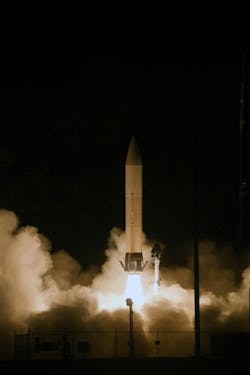DTS to build common hypersonic glide bodies for U.S. hypersonic strike weapons in $670.5 million contract
REDSTONE ARSENAL, Ala. – U.S. Army hypersonic munitions experts are asking Leidos Dynetics Technical Solutions (DTS) in Huntsville, Ala., to build glide bodies for hypersonic weapons that could see applications across all U.S. military services.
Officials of the Army Contracting Command at Redstone Arsenal, Ala., announced a $670.5 million contract to DTS last week to build the common hypersonic glide body and thermal protection system. DTS is a wholly owned subsidiary of Leidos Dynetics.
Commercial manufacturing
The Army hired DTS to produce the first commercially manufactured set of common hypersonic glide body systems. DTS is working with Lockheed Martin Corp. to support integration and prototyping of the new common hypersonic glide body, which is expected to be available across military services to provide commonality to air-, land-, and sea-launched hypersonic weapons.
The common hypersonic glide body is being developed by the U.S. Navy and Army to travel at hypersonic speeds and glide towards its target. A booster rocket accelerates the common hypersonic glide body to hypersonic speeds, then releases it to glide on its own. Hypersonic describes exceeding five times the speed of sound.
Lockheed Martin is working with the Army on multi-year hypersonic weapons development in support of the Army's focus on long-range precision-strike missiles.
Hypersonic strike weapon
Lockheed Martin is prime contractor for the Long-Range Hypersonic Weapon (LRHW) systems integration project. The Lockheed Martin-team will develop and integrate a land-based hypersonic strike missile prototype in partnership with the Army Hypersonic Project Office.
The Lockheed Martin LRHW team includes DTS; Integration Innovation Inc. (i3) in Huntsville, Ala.; Verity Integrated Systems in Huntsville, Ala.; Martinez & Turek Inc. in Rialto, Calif.; and Penta Research Inc. in Huntsville, Ala.
The LRHW prototype will capitalize on the common hypersonic glide body and introduce a new class of ultrafast and maneuverable long-range missiles with the ability to fire from mobile ground launchers. Hypersonic munitions travel at speeds at least as fast as Mach 5, or five times the speed of sound.
Hypersonic strike weapons are a key aspect of the Army's Long Range Precision Fires (LRPF) effort to develop long-range artillery-delivered munitions able to fire as far as 187 miles, as well as the national security strategy to compete with and outpace potential enemies in hypersonics.
On this contract DTS will do the work in Huntsville, Ala., and should be finished by October 2029. For more information contact Leidos Dynetics online at www.leidos.com/insights/dynetics, or the Army Contracting Command-Redstone at https://acc.army.mil/contractingcenters/acc-rsa/.
About the Author
John Keller
Editor-in-Chief
John Keller is the Editor-in-Chief, Military & Aerospace Electronics Magazine--provides extensive coverage and analysis of enabling electronics and optoelectronic technologies in military, space and commercial aviation applications. John has been a member of the Military & Aerospace Electronics staff since 1989 and chief editor since 1995.
